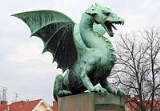morpheus
The origin of the European dragon is the famous Dacian battle standard, the "draco". Dacia is the ancient name of Romania. The word " draco" is still present in Romanian vocabulary under the form " drac" and it means dragon, devil, satan...
The Dacian standard was combined from the head of a wolf and the tail of a serpent.
The head was made either of silver or bronze, and had its mouth opened, showing the teeth and tongue. The particular shape of the mouth generated a powerful whistle when the wind passed through it. The tail was made of several cloth tubes, sewn one to another, and streamers. Because this standard was supposed to scare the enemy when rapidly floating in the air, The only Dacian Draco head that survives today was discovered in Germany.
On Traian's Column there are 20 standards of this kind, many of them different. The Traian's column commemorates Trajan's victory in the Dacian Wars.
After the Romans conquered Dacia, the military units composed by inhabitants of Dacia kept their standard as personal signum. Lucius Flavius Arrianus, commander of the Roman legions on the frontier with Armenia, described the Dacian Dracos used by Ala I Ulpia Dacorum in his work Tactica (136 A.D.), where he calls the Dacians "Scythians":
"The Roman riders are advancing with different insignia, not only Roman but also Scythian, so that their incursions look more varied and more scary. The Scythian insignia represent some dragons, proportional in size with the rod they are attached to. They are made of pieces of cloth of various colors, sewn together. These dragons have their head and entire body resembling the snakes. This strategy was invented so that the dragons would appear as terrifying as possible. When the horses stand in place, one can't see anything more than pieces of cloth of various colors that lies down. But when the horses run, these dragons inflate themselves with air, bearing a great resemblance with the beasts and whistling strongly, because the air runs powerfully trough them. These insignia aren't just pleasant to the eyes, but are useful in distinguishing the attackers during the battle and helping the riders not to get into a tangle."
A historical theory says that the dragon on the flag of Wales is a heritage of the Dacian Draco, brought in Britannia by Cohors I Aelia Dacorum during the reign of the Roman emperor Hadrian (117-138 A.D.).
The dacian-roman legions were based in fort Banna (Birdoswald)
The Dacian standard was combined from the head of a wolf and the tail of a serpent.
The head was made either of silver or bronze, and had its mouth opened, showing the teeth and tongue. The particular shape of the mouth generated a powerful whistle when the wind passed through it. The tail was made of several cloth tubes, sewn one to another, and streamers. Because this standard was supposed to scare the enemy when rapidly floating in the air, The only Dacian Draco head that survives today was discovered in Germany.
On Traian's Column there are 20 standards of this kind, many of them different. The Traian's column commemorates Trajan's victory in the Dacian Wars.
After the Romans conquered Dacia, the military units composed by inhabitants of Dacia kept their standard as personal signum. Lucius Flavius Arrianus, commander of the Roman legions on the frontier with Armenia, described the Dacian Dracos used by Ala I Ulpia Dacorum in his work Tactica (136 A.D.), where he calls the Dacians "Scythians":
"The Roman riders are advancing with different insignia, not only Roman but also Scythian, so that their incursions look more varied and more scary. The Scythian insignia represent some dragons, proportional in size with the rod they are attached to. They are made of pieces of cloth of various colors, sewn together. These dragons have their head and entire body resembling the snakes. This strategy was invented so that the dragons would appear as terrifying as possible. When the horses stand in place, one can't see anything more than pieces of cloth of various colors that lies down. But when the horses run, these dragons inflate themselves with air, bearing a great resemblance with the beasts and whistling strongly, because the air runs powerfully trough them. These insignia aren't just pleasant to the eyes, but are useful in distinguishing the attackers during the battle and helping the riders not to get into a tangle."
A historical theory says that the dragon on the flag of Wales is a heritage of the Dacian Draco, brought in Britannia by Cohors I Aelia Dacorum during the reign of the Roman emperor Hadrian (117-138 A.D.).
The dacian-roman legions were based in fort Banna (Birdoswald)


